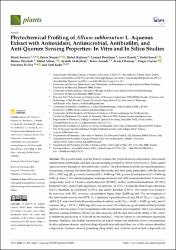Phytochemical Profiling of Allium subhirsutum L. Aqueous Extract with Antioxidant, Antimicrobial, Antibiofilm, and Anti-Quorum Sensing Properties: In Vitro and In Silico Studies

Göster/
Tarih
2022Yazar
Snoussi, MejdiNoumi, Emira
Hajlaoui, Hafed
Bouslama, Lamjed
Hamdi, Assia
Saeed, Mohd
Ceylan, Özgür
Üst veri
Tüm öğe kaydını gösterKünye
Snoussi, M.; Noumi, E.; Hajlaoui, H.; Bouslama, L.; Hamdi, A.; Saeed, M.; Alreshidi, M.; Adnan, M.; Al-Rashidi, A.; Aouadi, K.; et al. Phytochemical Profiling of Allium subhirsutum L. Aqueous Extract with Antioxidant, Antimicrobial, Antibiofilm, and Anti-Quorum Sensing Properties: In Vitro and In Silico Studies. Plants 2022, 11, 495. https://doi.org/10.3390/plants11040495Özet
The present study was the first to evaluate the phytochemical composition, antioxidant, antimicrobial, antibiofilm, and anti-quorum sensing potential of Allium subhirsutum L. (hairy garlic) aqueous extract through in vitro and in silico studies. The phytochemical profile revealed the presence of saponins, terpenes, flavonols/flavonones, flavonoids, and fatty acids, particularly with flavonoids (231 +/- 0.022 mg QE/g extract), tannins (159 +/- 0.006 mg TAE/g extract), and phenols (4 +/- 0.004 mg GAE/g extract). Gas chromatography-mass spectrometry (GC-MS) analysis identified 15 bioactive compounds, such as 5-hydroxymethylfurfural (37.04%), methyl methanethiolsulfonate (21.33%), furfural (7.64%), beta-D-glucopyranose, 1,6-anhydro- (6.17%), 1,6-anhydro-beta-D-glucofuranose (3.6%), trisulfide, di-2-propenyl (2.70%), and diallyl disulfide (1.93%). The extract was found to be non-toxic with 50% cytotoxic concentration higher than 30,000 mu g/mL. The investigation of the antioxidant activity via DPPH (2, 2-diphenyl-1-picrylhydrazyl) and FRAP (IC50 = 1 mu g/mL), ABTS (2,2 '-azino-bis(3-ethylbenzothiazoline-6-sulfonic acid); IC50 = 0.698 +/- 0.107 mu g/mL), and beta-carotene (IC50 = 0.811 +/- 0.036 mg/mL) was assessed. Nevertheless, good antimicrobial potential against a diverse panel of microorganisms with bacteriostatic and fungistatic effect was observed. Quorum sensing inhibition effects were also assessed, and the data showed the ability of the extract to inhibit the production of violacein by the mutant C. violaceum strain in concentration-dependent manner. Similarly, the biofilm formation by all tested strains was inhibited at low concentrations. In silico pharmacokinetic and toxicological prediction indicated that, out of the sixteen identified compounds, fourteen showed promising drug ability and could be used as lead compounds for further development and drug design. Hence, these findings support the popular use of hairy garlic as a source of bioactive compounds with potential application for human health.

















